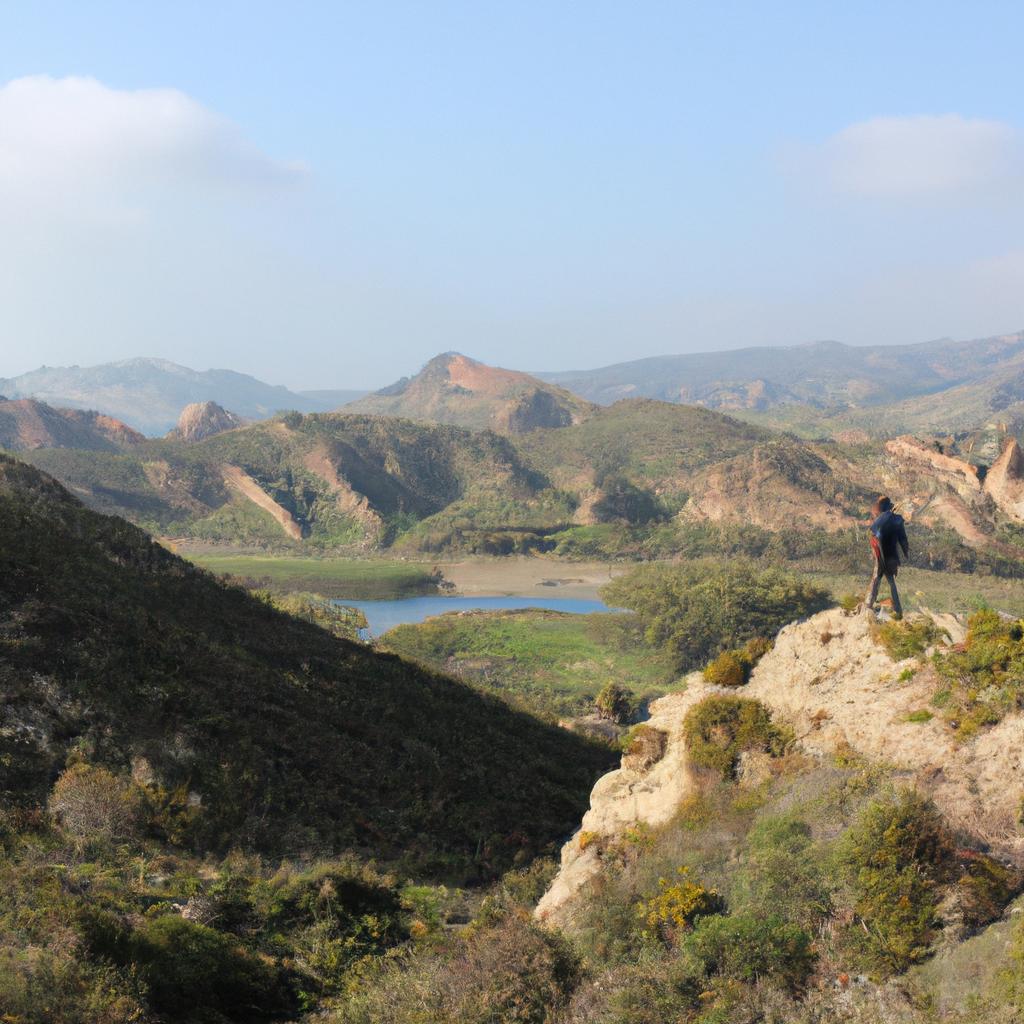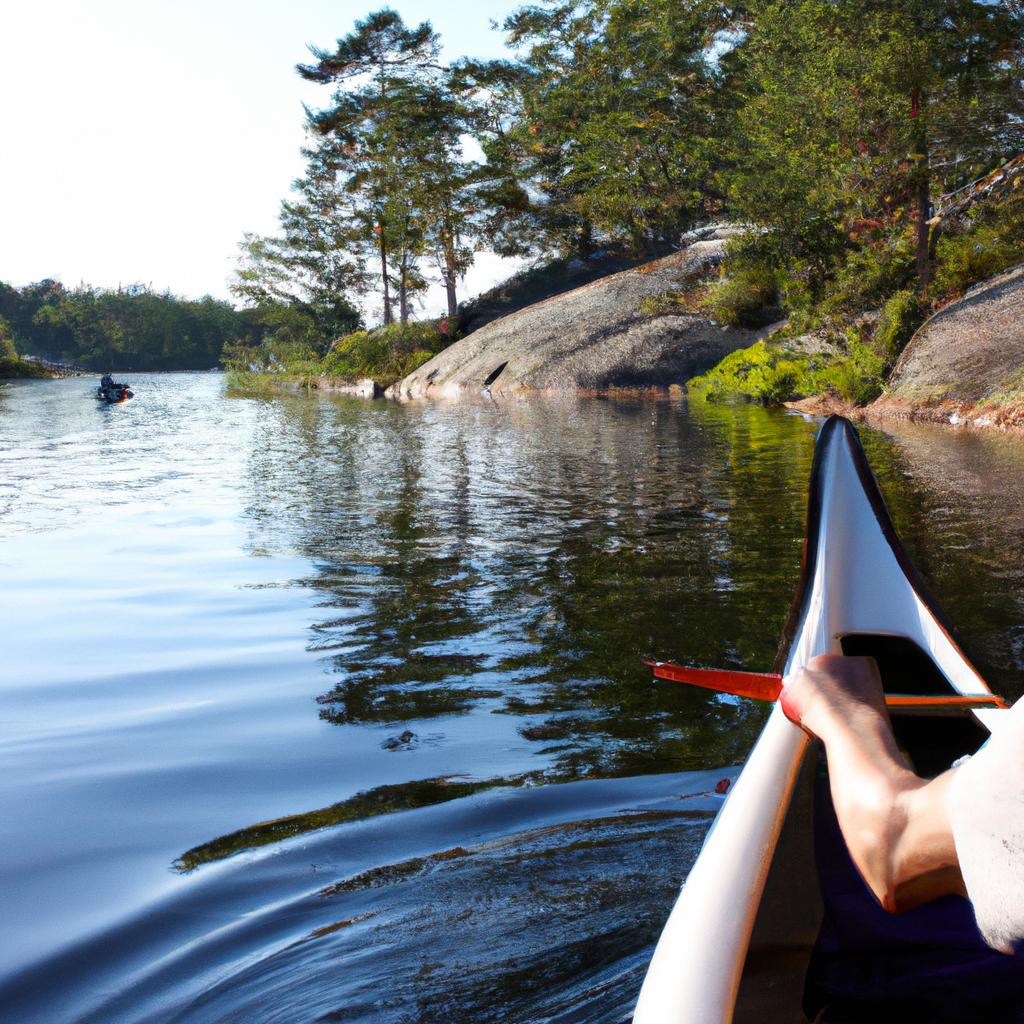Wildlife watching has become an increasingly popular activity for outdoor enthusiasts and nature lovers in North America. This article serves as a comprehensive guide to wildlife watching, providing valuable information and insights into the best destinations, techniques, and ethical considerations for engaging in this captivating pursuit. By exploring one example of a successful wildlife-watching experience, we will delve into the importance of proper preparation and responsible behavior while observing these fascinating creatures.
One exemplary case study that exemplifies the excitement and rewards of wildlife watching involves venturing into Jasper National Park in Alberta, Canada. In this breathtaking natural setting, visitors have the opportunity to observe majestic elk herds grazing peacefully against a backdrop of towering mountains. The thrill of witnessing these magnificent animals up close is heightened by their graceful movements and powerful presence. However, such encounters require careful planning and adherence to guidelines that ensure both human safety and animal welfare.
This article aims to equip readers with essential knowledge about wildlife watching in North America so they can make informed choices during their outdoor adventures. Whether individuals are seasoned wildlife watchers seeking new experiences or beginners eager to explore this realm for the first time, understanding the best practices, potential challenges, and environmental impacts associated with this activity is crucial. By following recommended guidelines and adopting a respectful approach towards the natural world , wildlife watchers can not only enhance their own experience but also contribute to the conservation and protection of the species they encounter.
One of the first steps in preparing for a wildlife-watching adventure is to research and choose an appropriate destination. North America offers a vast array of habitats and ecosystems that support diverse wildlife populations. National parks, wildlife refuges, and protected areas are often excellent choices as they provide opportunities to observe animals in their natural habitats while ensuring their safety and preservation. Additionally, consulting local experts or joining organized tours led by knowledgeable guides can greatly enhance the chances of encountering wildlife and learning about their behaviors.
Once a suitable destination has been selected, it is important to familiarize oneself with local regulations and guidelines governing wildlife watching activities. These guidelines typically include maintaining a safe distance from animals, refraining from feeding them, and respecting their natural behaviors. Respecting boundaries ensures both human safety and animal welfare while minimizing stress on the animals caused by human interference.
Choosing the right equipment is another crucial aspect of wildlife watching. Binoculars or spotting scopes can help viewers observe animals from a distance without disturbing them. Telephoto lenses for cameras allow for close-up shots while maintaining a safe distance. It is important to remember that capturing memories should never take precedence over the well-being of the animals or their habitat.
Ethical considerations play a significant role in responsible wildlife watching. Patience is key when waiting for animals to appear or exhibit interesting behavior naturally. Avoid disrupting their routines or habitat by staying on designated trails or viewing areas whenever possible. Being quiet and avoiding sudden movements helps prevent unnecessary stress to the animals.
Lastly, it is essential to be mindful of environmental impacts while participating in wildlife watching activities. Leave no trace principles should be followed by minimizing noise pollution, disposing of waste responsibly, and refraining from removing any natural materials or artifacts from the ecosystem.
By adhering to these guidelines, individuals can enjoy memorable encounters with North America’s magnificent wildlife while contributing to their conservation and well-being. Remember, responsible wildlife watching not only provides personal fulfillment but also ensures the long-term preservation of these remarkable creatures for future generations to appreciate and admire.
Best Wildlife Watching Spots in North America
Imagine standing on the shores of Lake Yellowstone, binoculars in hand, as you witness a majestic bald eagle swooping down to catch its prey. This is just one example of the countless awe-inspiring moments that await wildlife enthusiasts in North America. From coast to coast, this vast continent offers an array of breathtaking destinations for observing diverse animal species in their natural habitats.
One such remarkable spot is Denali National Park and Preserve in Alaska. Spanning over six million acres, it encompasses towering mountains and expansive tundra where visitors can encounter grizzly bears, moose, caribou herds, and even elusive wolves. The park’s remote location provides an authentic wilderness experience and allows for unparalleled opportunities to observe these magnificent creatures up close.
For those seeking marine encounters, Monterey Bay in California presents an ideal destination. With its nutrient-rich waters and unique underwater topography, this area attracts a rich diversity of marine life. Visitors can embark on whale-watching tours or simply stand along the shoreline to marvel at the sight of humpback whales breaching the surface or pods of dolphins gracefully leaping through the waves.
To truly immerse oneself in the wonders of avian fauna, Bosque del Apache National Wildlife Refuge in New Mexico should not be missed. Every winter, thousands of sandhill cranes and snow geese flock to this sanctuary during their migratory journey southward. Witnessing these elegant birds take flight against a backdrop of vibrant sunsets creates an unforgettable spectacle that touches both heart and soul.
As we explore further across North America’s diverse landscapes, we discover yet another exceptional site: Churchill in Manitoba, Canada – often referred to as the “Polar Bear Capital.” Located on Hudson Bay’s edge, this region becomes home to hundreds of polar bears each fall as they wait for sea ice formation. Observing these mighty predators roam the coastal areas from specialized vehicles known as tundra buggies offers a thrilling adventure that is unparalleled anywhere else on the planet.
In summary, North America boasts an abundance of remarkable wildlife watching spots. Whether it’s witnessing bald eagles soar above Yellowstone Lake, encountering grizzly bears in Denali National Park, marveling at majestic marine creatures in Monterey Bay, observing graceful sandhill cranes and snow geese in Bosque del Apache, or experiencing the awe-inspiring presence of polar bears in Churchill – each location provides a unique opportunity to connect with nature and gain a deeper appreciation for the incredible biodiversity found across this vast continent.
Continuing our journey into the wilds of North America, let us now delve into essential tips for maximizing your wildlife observation experiences.
Tips for Wildlife Observation in North America
Imagine you are deep in the heart of a national park, patiently waiting for a glimpse of an elusive creature. Suddenly, your perseverance pays off as a majestic bald eagle soars above you, its wings outstretched against the blue sky. This captivating experience is just one example of the countless wildlife encounters awaiting avid nature enthusiasts throughout North America.
Ethical Considerations:
When engaging in wildlife watching activities, it is crucial to uphold ethical standards that prioritize the well-being and conservation of the animals involved. By following these principles, we can ensure that our presence has minimal impact on their natural behaviors and habitats:
-
Respectful Distance:
- Maintain a safe distance from wildlife, using binoculars or telephoto lenses to observe them up close.
- Keep noise levels to a minimum and avoid sudden movements that may startle or distress the animals.
-
Leave No Trace:
- Properly dispose of all waste and litter to prevent contamination of natural environments.
- Stay on designated trails and respect any restricted areas to minimize disturbance to sensitive ecosystems.
-
Do Not Feed Wildlife:
- Feeding wild animals disrupts their natural foraging patterns and can lead to dependency issues or aggressive behavior towards humans.
- Avoid offering food or tempting animals with human-made treats; instead, let them find sustenance through their own instincts.
-
Responsible Photography:
| Tips for Ethical Wildlife Photography |
|---|
| 1. Use quiet camera settings like silent shutter mode |
| 2. Turn off flash photography |
| 3. Never alter or bait animal habitats for better photographs |
| 4. Be patient and allow animals to approach naturally |
By adhering to these ethical guidelines during wildlife observation trips in North America, we contribute positively to the preservation of biodiversity while creating unforgettable memories. In our next section, we will delve into the fascinating world of endangered species found in North America, highlighting the importance of their conservation efforts. Let us embark on this journey to understand and protect these remarkable creatures that share our planet.
Endangered Species to Look out for in North America
Transitioning smoothly from the previous section on “Tips for Wildlife Observation in North America,” let us now delve into the fascinating world of endangered species to look out for in this region. To illustrate the importance of conservation efforts, consider a hypothetical scenario where an endangered species, such as the California condor, is being closely monitored and protected.
The California condor, with its massive wingspan and striking appearance, serves as a poignant example of wildlife preservation. With just 27 individuals left in the wild during the early 1980s, intensive conservation measures were implemented to save them from extinction. Through captive breeding programs and habitat restoration initiatives, their population has slowly increased over time. Today, it stands at approximately 450 birds; however, these majestic creatures still require ongoing support to ensure their long-term survival.
To further understand the significance of protecting endangered species like the California condor, here are some key points to ponder:
- Biodiversity: Endangered species contribute to the overall biodiversity of ecosystems by occupying unique ecological niches. Their disappearance can disrupt critical interactions within food chains and lead to cascading effects on other plant and animal populations.
- Ecotourism: Many travelers are drawn to destinations that offer opportunities for wildlife observation. The presence of charismatic endangered species enhances ecotourism experiences while generating economic benefits for local communities.
- Ecosystem Services: Endangered species play vital roles in maintaining ecosystem services such as pollination, seed dispersal, and pest control. Losing these species could have far-reaching consequences for human societies’ well-being and livelihoods.
- Ethical Responsibility: As stewards of our planet’s natural heritage, we hold an ethical responsibility to conserve biodiversity and protect vulnerable species from extinction.
| Species | Habitat | Conservation Status |
|---|---|---|
| California Condor | Coastal Mountains | Critically Endangered |
| Mexican Gray Wolf | Southwest U.S. | Endangered |
| Florida Panther | Everglades | Critically Endangered |
| Karner Blue Butterfly | Northeastern U.S. | Federally Threatened |
As we reflect on the significance of safeguarding endangered species, it becomes evident that our actions today will shape the future of these remarkable creatures and their habitats. In the subsequent section about “Equipment and Gear for Wildlife Watching in North America,” we will explore how to best equip ourselves for captivating encounters with these awe-inspiring animals.
Now let’s transition into the next section: “Equipment and Gear for Wildlife Watching in North America.”
Equipment and Gear for Wildlife Watching in North America
When embarking on a wildlife watching adventure in North America, it is important to have an understanding of the diverse habitats that support various species. One notable example is the Everglades National Park in Florida, which provides a unique ecosystem for numerous endangered species. For instance, the critically endangered Florida panther relies on this vast subtropical wilderness as its primary habitat.
To fully appreciate and maximize your chances of encountering wildlife, consider these key factors:
- Habitat Diversity: Different habitats support distinct species. From dense forests to open grasslands, each environment offers a range of biodiversity.
- Seasonal Variations: Certain animals may migrate or hibernate during specific seasons, so timing your visit can greatly impact what you see.
- Food Sources: Understanding the food preferences and availability for different species can help guide your search efforts.
- Water Resources: Bodies of water are vital for many species’ survival; rivers, lakes, and wetlands often attract a wide array of wildlife.
| Habitat Type | Notable Species |
|---|---|
| Forests | Black bears |
| Grasslands | Bison |
| Wetlands | Alligators |
| Mountains | Bighorn sheep |
By immersing yourself in these varying landscapes across North America’s extensive geographical regions, you increase your chances of witnessing remarkable animal encounters up close.
Transitioning from discussing habitats leads us to explore responsible practices when engaging with wildlife in their natural environments.
Responsible Wildlife Watching Practices in North America
Transitioning from our discussion on equipment and gear, it is crucial to understand the importance of responsible wildlife watching practices in North America. By following ethical guidelines, we can ensure the well-being of the animals and preserve their natural habitats for future generations.
For instance, imagine you are visiting a national park in Canada known for its diverse bird species. As you approach a nesting area, you notice several signs indicating that disturbing or feeding the birds is strictly prohibited. This serves as a reminder that respecting boundaries and maintaining distance from wildlife is essential for their safety and conservation.
To promote responsible wildlife watching in North America, consider the following key practices:
-
Maintain a safe distance: Keep at least 100 yards (approximately 91 meters) away from most large mammals such as bears, wolves, or moose. Respect their personal space to avoid causing stress or altering their behavior.
-
Do not feed wild animals: Feeding wildlife disrupts natural food sources and can lead to dependency on human-provided resources. It also increases the risk of disease transmission between humans and animals.
-
Stay on designated trails: Stick to established paths when observing wildlife to minimize disturbance to sensitive ecosystems. Straying off-trail can trample vegetation or disturb nests, impacting the overall balance of these environments.
-
Minimize noise and use appropriate photography techniques: Loud noises can startle animals and interfere with their natural behaviors. When photographing wildlife, opt for silent mode settings on your camera and refrain from using flash unless absolutely necessary.
By adhering to these responsible practices, we contribute to preserving the beauty of North America’s fauna while ensuring minimal impact on their lives and habitats.
Understanding how to responsibly engage with wildlife sets the stage for unique encounters that allow us to appreciate nature’s wonders even more deeply.
Unique Wildlife Encounters in North America
Transitioning from responsible wildlife watching practices, let us now delve into the captivating world of unique wildlife encounters that await travelers in North America. Picture this: you find yourself standing on the outskirts of a dense forest in the Pacific Northwest, silently observing as a family of majestic wolves emerges from within the trees. This extraordinary moment exemplifies just one of the many unforgettable experiences that can be had while exploring the diverse landscapes and ecosystems across North America.
To truly immerse oneself in these remarkable encounters, it is essential to understand the intricate balance between human observation and respecting animal habitats. By adhering to responsible guidelines, visitors increase their chances of witnessing nature’s wonders firsthand. Here are some key considerations:
- Maintain a safe distance: Admiring animals from afar not only ensures your safety but also minimizes disturbance to their natural behavior.
- Stay quiet and still: Remaining calm and silent allows for uninterrupted observations without causing unnecessary stress or alarm among wildlife.
- Avoid feeding or touching animals: Interfering with an animal’s diet or physical space disrupts their natural instincts and may lead to dependency on humans.
- Follow designated trails and areas: Respect boundaries set by park authorities or local guides to minimize habitat disruption and protect sensitive species.
As we explore further, let us take a closer look at some incredible instances where travelers have been fortunate enough to witness breathtaking wildlife encounters throughout North America:
| Encounter | Location | Animal Species |
|---|---|---|
| 1 | Yellowstone National Park, Wyoming | Grizzly bears |
| 2 | Churchill, Manitoba (Canada) | Polar bears |
| 3 | Everglades National Park, Florida | American alligators |
| 4 | Denali National Park, Alaska | Moose |
These thrilling examples merely scratch the surface of what awaits those who embark on wild adventures across North America. From the iconic grizzly bears of Yellowstone National Park to the awe-inspiring polar bears of Churchill, Manitoba, each encounter holds its own unique charm and provides an opportunity for a deeper connection with nature.
In summary, responsible wildlife watching practices serve as our gateway to extraordinary encounters with North America’s diverse fauna. By adhering to guidelines that protect both ourselves and the animals we observe, we increase the likelihood of experiencing firsthand moments that will forever resonate in our memories. So grab your binoculars and embark on a journey filled with wonder, as you witness these captivating creatures amid their natural habitats.
 Island Gourmet Safaris
Island Gourmet Safaris



